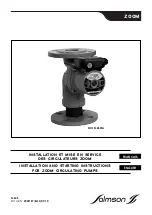
ENGLISH
INTRODUCTION
JBL craftsmen have been involved in the art of sound for
more than two generations – signal and source, wood
and fabric, transducers and acoustics – all of it.
JBL loudspeakers are carefully engineered instruments,
painstakingly crafted and assembled to watchmaker stan-
dards. JBL transducers and electronics offer what has
been characterized by devoted music listeners as "the
incomparable JBL sound".
By following the few simple suggestions contained in this
booklet, you can look forward to superb high fidelity
reproduction that will retain its clarity and realism year
after year.
We strongly suggest that you keep the packing material
for future purposes, in case you are moving or your loud-
speakers should require service.
PLACEMENT
Your JBL XTi-Series speakers offer satisfying sound in a
great variety of listening rooms when set up in an equilat-
eral triangle with respect to the listener. However, careful
setup will always be rewarded, and for best results we
recommend placement well away from the boundaries of
the room with preferably minimum 0.75 m (30 in) dis-
tance to the wall behind the speakers, and 0.75-1.0 m
(30-40 in) distance to the side walls.
Your authorized JBL dealer will be happy to help you
obtain the best possible performance from your JBL
speakers.
NOTE:
New loudspeakers require a certain amount of
"exercise" before they perform their best. A steady level
of performance is achieved after 8-12 hours of operation,
depending on the nature of the music and the level.
CONNECTIONS
IMPORTANT:
When connecting or disconnecting loud-
speakers from an amplifier, the amplifier must be turned
off. Making connections while the amplifier is operating
could seriously damage the loudspeaker system and void
the warranty. The amplifier must also be turned off before
connecting or disconnecting cables, at the amplifier or
pre-amplifier inputs.
1 mm
2
(18 AWG) insulated wire is the minimum size rec-
ommended for loudspeaker connection up to 5 meters
(16 ft). Beyond this distance, heavier gauge wire is recom-
mended.
Speaker wire and interconnect cables are important com-
ponents in an audio system. With all other factors at an
appropriate level of quality the speaker cable and the
interconnect cable can make significant contributions to
the perceived sound quality. Careful selection of cable
and interconnect can add or subtract marked shadings in
the tonal character. Likewise, different cables can have
quite a dramatic impact on the dynamic contrasts experi-
enced by listeners.
Your JBL dealer has the experience and knowledge to rec-
ommend suitable interconnects and speaker wire to best
complement your system.
Connections to the loudspeaker system are made at the
terminals located on the back of the enclosure. These ter-
minals permit a variety of connection methods.
The most straightforward connection is made by directly
connecting clean bare wire. This connection is made by
stripping 8-10 mm of insulation off the loudspeaker wire
and passing the bare wire through the hole in the binding
post. The knob can now be tightened securely, and any
excess wire that is not in contact with the binding post
surfaces should be trimmed to avoid short circuits.
A very convenient way of connection is the use of 4 mm
banana connectors, which are then, in turn, connected to
the binding posts. Bear in mind, however, that the num-
ber of contact points should be kept to a minimum, and
at the same time each contact should be as tight as
possible.
For the same reason, we recommend the use of the high-
est quality spade connectors, expertly connected to the
selected cables. Spade lugs will make the best possible
connection between the speaker wire and the loudspeak-
er system, minimizing any contact resistance that might
degrade the sound ever so slightly.
It is essential that both loudspeakers in a stereo system
have the same polarity with respect to the input signal
(are in "phase"). JBL XTi-Series are designed to produce a
positive pulse when a positive signal is applied to the red
input terminal.
If the driver cones of the two loudspeakers do not move
in the same direction for a given voltage at the input ter-
minals, there will be a lack of stereo definition and a loss
of deep bass.
We recommend experimenting with the polarity of the
speakers, since recordings, program sources or power
amplifiers can invert the polarity of the signal. The "cor-
rect" connection is the one that yields the best audible
results. Be sure to reverse both left and right connections
to keep the systems in polarity.




































